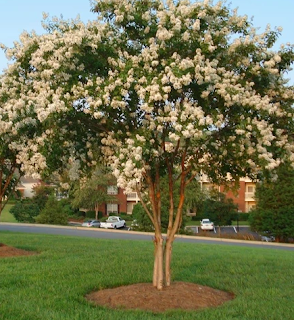The Acoma crape myrtle is a Lagerstroemia hybrid cultivar that is most commonly known as the crape (or crepe) myrtle. This type grows to a maximum height of around 10 feet and is typically characterized as staying small and more shrub-like in appearance rather than resembling a tree.
These plants are ideal for growing in urban and suburban areas. Because of its tiny size, it is suitable for gardens or lawns, or it can be used as part of a commercial landscaping scheme. Crape myrtle trees frequently suffer from powdery mildew, but this cultivar is more resistant to it.
As it produces weeping branches with rich foliage and exquisite blossoms, the Acoma crape myrtle is a delightful shrub or small tree to grow. Even though this variety prefers full sun, it thrives in a wide range of soil types and only requires minimal watering and fertilization.
Crape myrtle is adaptable to a variety of soil types—loam, clay, or sandy—as long as the area is well-drained. These plants need slightly acidic to neutral soil pH levels, but they can also grow in slightly alkaline soils.
When the crape myrtle is first planted, it will require regular watering to establish. However, once they've reached maturity, these plants only require approximately an inch of water every week.
Acoma Crape Myrtle Growth rate
With a moderate growth rate, you'll have plenty of time to observe these trees mature. Simply keep an eye on it; the Acoma crape myrtle needs only periodic pruning of its lowest branches.

Crape myrtle requires full sun to bloom to its greatest potential. These plants are well-known for their stunning flowers, and to maximize the display, ensure that your crape myrtle gets at least 6 hours of direct sunlight each day.
Acoma Crape Myrtle Size & Height
Acoma grows to a maximum height of 9.5 feet (2.9 meters) and a width of 11 feet (3.3 meters). Multiple trunks are common in trees. As a result, these trees can grow wider than they are tall.
FAQ's
What is difference between Acoma Crape Myrtle vs. Natchez
Natchez crape myrtle is a tall shrub or small tree with exfoliating bark that is smooth, dark, cinnamon brown, and smooth. Leaf coloration changes from glossy dark green to fiery orange-red in the fall. Throughout the summer, panicles of pure white, soft-textured flowers appear. It's ideal as a specimen, accent, or group planting, whereas Acoma crape myrtle is good for growing in cities and suburbs. It is appropriate for gardens or lawns due to its small size, or it can be utilized as a part of a commercial landscaping project. Powdery mildew is a common problem for crape myrtle trees, although this cultivar is more resistant to it.
How to prune an Acoma crape myrtle?
After its root system has been established, you can reduce the amount of water it receives. Pruning is not required when growing Acoma crape myrtles. Some gardeners, on the other hand, remove lower branches to reveal the beautiful trunk. If you must prune, do so in the late winter or early spring before the growth cycle begins.
How big do semi-dwarf crape myrtles get?
Dwarf variants only reach a maximum height of 4 feet. Semi-dwarf cultivars reach a height of 4 to 8 feet. The Large Crapemyrtle, or Tree Crapemyrtle, grows to a height of 10 to 20 feet. By selecting a variety that is appropriately suited for your location, you can avoid the need for extensive trimming.







0 Comments
For comments please reply here.......